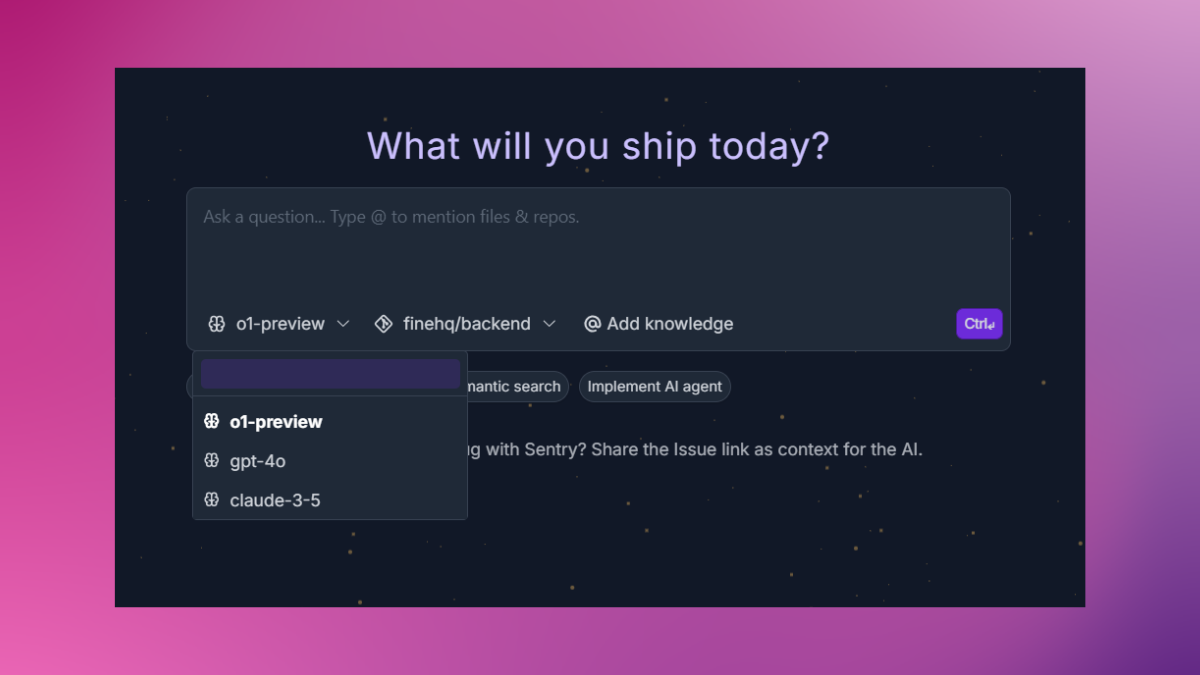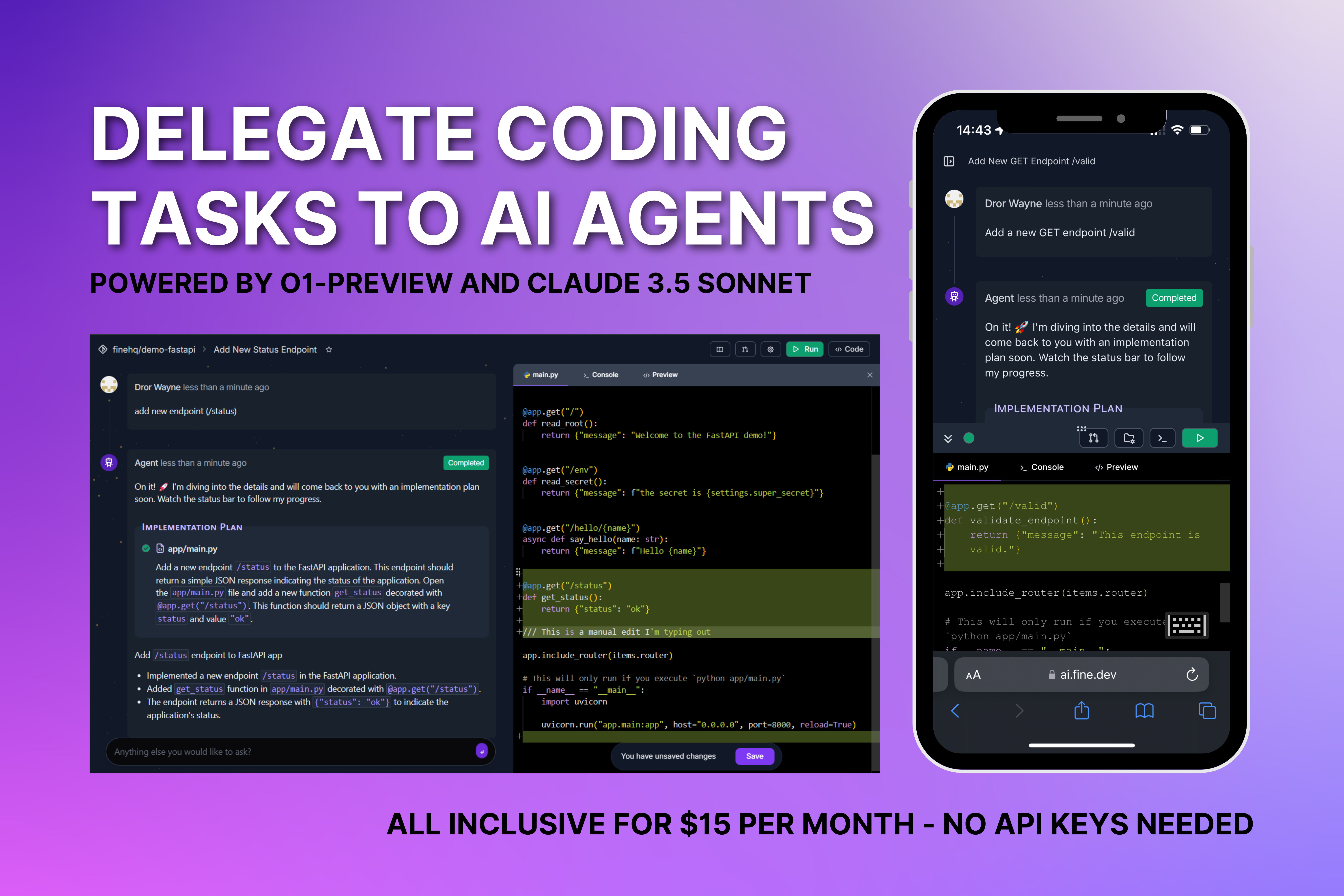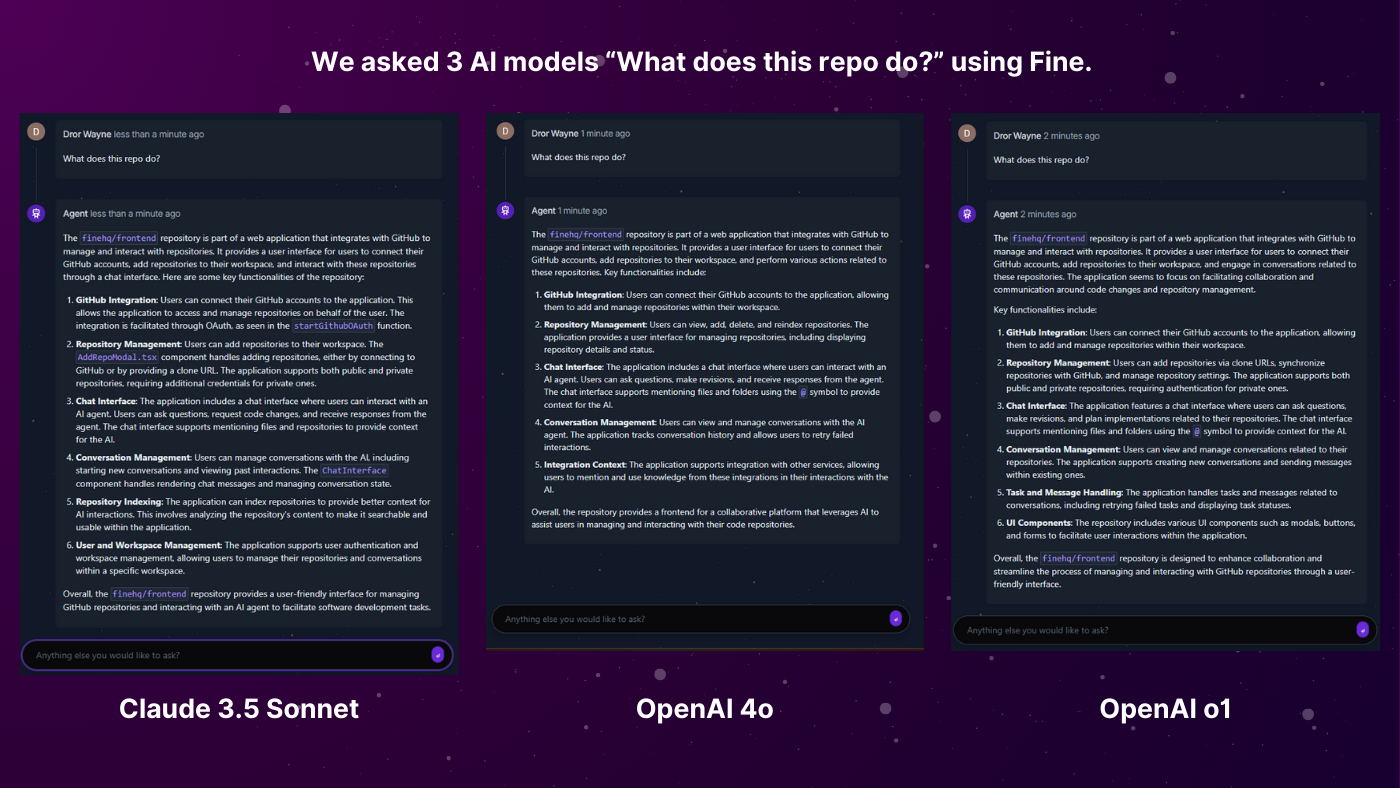OpenAI o1 vs. Claude Sonnet 3.5: Which AI Model is Best for Coding?
Introduction
As AI continues to evolve, two models stand out: o1 by OpenAI and Claude Sonnet 3.5 by Anthropic. Both offer impressive capabilities for software developers, but their strengths vary, especially when it comes to coding. This blog compares these two AI models, focusing on coding tasks and general performance. Fine includes unlimited access to both models, making it a great way to test and compare how o1 and Sonnet perform with coding tasks.

Core Differences
o1 is designed for complex reasoning and problem-solving. Its responses are deep and thoughtful, making it ideal for developers working on intricate problems or needing detailed explanations. On the other hand, Claude Sonnet 3.5 focuses on efficiency and speed, excelling in rapid response times while being more cost-effective. If you're looking to quickly generate code or handle high-volume tasks, Claude Sonnet 3.5 may be the better option.
Both models use transformer-based architectures, but o1 is more suited for developers seeking detailed reasoning, while Claude Sonnet 3.5 is the go-to for those who prioritize speed.
Context Window and Performance
The context window plays a crucial role in how well these models handle large inputs or extended conversations. ChatGPT o1 supports 128,000 tokens, while Claude Sonnet 3.5 handles a larger 200,000 tokens, giving it an advantage for tasks that require significant context retention, such as reviewing long codebases.
Both models offer strong performance in a range of tasks, but their abilities shine in different areas. ChatGPT o1 excels in multistep reasoning, explaining complex code logic in detail, while Claude Sonnet 3.5 focuses on rapid, efficient bug fixes and code generation.
Claude 3.5 Sonnet Upgraded Version - October 2024 - Is Claude now better than GPT for Coding?
In October 2024, Anthropic announced an upgraded version of Claude 3.5 Sonnet. The recent updates to Claude 3.5 Sonnet have significantly enhanced its software engineering capabilities. Notably, the model's performance on the SWE-bench Verified benchmark has improved from 33.4% to 49.0%, surpassing all publicly available models, including OpenAI's o1-preview.
This advancement reflects Claude 3.5 Sonnet's enhanced accuracy in function generation and error checking, particularly in debugging and refactoring code involving nested functions or interdependent segments. Additionally, the model's expanded token capacity allows it to retain and utilize more extensive context, making it ideal for reviewing large codebases or managing intricate projects with multiple dependencies. Early testing indicates that Claude 3.5 Sonnet excels in specialized coding tasks, such as identifying security vulnerabilities in web applications and optimizing algorithms for speed and efficiency. GitLab, for instance, reported up to a 10% improvement in reasoning capabilities for DevSecOps tasks with the updated model, without any increase in latency.
AI use cases for coding with o1 and Claude Sonnet 3.5
ChatGPT o1:
- Debugging complex React state management: Use o1 to deeply analyze why certain states aren’t updating properly or conflicting across components.
- Refactoring legacy code: Employ o1’s thorough reasoning to restructure an old Python script for readability and maintainability.
- Creating algorithms: Ideal for writing and explaining algorithms like sorting, tree traversal, or dynamic programming in detail.
Claude Sonnet 3.5:
- Generating boilerplate code: Quickly create setup files for new projects like Flask APIs or front-end scaffolding in Next.js.
- Auto-completing functions: Use it to complete a half-written JavaScript function with appropriate error handling and edge cases.
- Bulk code generation: Sonnet 3.5 excels in producing repetitive yet slightly varied code structures like similar API endpoints or unit test cases.

Which AI Models do the different AI coding tools use?
There are lots of dev tools available today to help with your AI coding, from advanced AI coding assistants such as Fine to code generators such as GitHub Copilot. Some use multiple LLMs, some give you the choice and others are based on one model only.
Which AI Model (LLM) does Fine use?
Fine is one of the few AI coding tools to offer users the choice between different LLMs for various tasks. When using Fine via the web browser, users can choose between o1-preview, 4o and Claude 3.5 Sonnet. You'll need a pro subscription to take advantage of this however, which is $13-15 per month. If you're a free user, you'll be able to use Fine with 4o. Click here to try it out.
Which AI Model (LLM) does GitHub Copilot use?
GitHub Copilot is heavily integrated with OpenAI. GitHub is owned by Microsoft who have a deep partnership with OpenAI. Most users have access to 4o, whilst Azure AI subscribers may be able to use GitHub Copilot with o1-mini and o1-preview.
UPDATE: At GitHub Universe 2024, it was announced that this exclusive partnership was no longer so exclusive and that the option to use Claude would be rolled out to all GitHub Copilot users shortly. Some users have already been able to access Claude. It's available in the Copilot Chat in Visual Studio Code and Immersive Copilot in the web browser only.
Which AI Model (LLM) does Cursor use?
Cursor uses Claude 3.5 Sonnet by default and falls back to OpenAI 4o during Anthropic outages.
Which AI Model (LLM) does Bolt use?
Bolt, the AI coding tool that specializes exclusively in front-end, relies on Claude 3.5 Sonnet.
Which AI Model (LLM) does Replit use?
Although Replit previously released their own AI model in 2023, when they announced Replit Agent, their primary AI coding too, in 2024, it seems they took the decision to use Claude 3.5 Sonnet.
How to compare different AI Coding tools and LLMs?
If you're looking to compare which are the best AI coding tools or LLMs, there are a few things to bare in mind.
First, it's important to assess the LLM and the tool separately. Use a tool like Fine that allows you to give the same task to multiple LLMs to compare which gives you the best result. Here's a comparison we did of the three models offered by Fine, posed with the same question: What does this repo do? (It's a question that some are calling the Hello World of AI coding).

Second, compare how the tools perform with your chosen LLM, specific to your use case. Fine offers a variety of integrations to boost your productivity, such as the ability to make revisions inside GitHub PR, that are saving developers hours every week.
Which Model Is Better for Coding?
For coding tasks, your choice depends on your needs:
-
ChatGPT o1 is the better option when working on complex, multistep problems where you need deep reasoning and thorough explanations. For example, it excels in explaining intricate code or assisting with debugging in a more thoughtful manner.
-
Claude Sonnet 3.5 is the go-to model for fast, efficient code generation and iterative prototyping. It's cost-effective for high-volume tasks like generating multiple code snippets or automating bug fixes.
Both models support developers in coding, but Claude Sonnet 3.5 may save time and money for everyday coding tasks, while ChatGPT o1 might be your ally for tougher, detailed coding problems.
Conclusion
When deciding between ChatGPT o1 and Claude Sonnet 3.5, consider the complexity of your coding tasks and budget constraints. ChatGPT o1 offers better problem-solving for intricate tasks, while Claude Sonnet 3.5 provides faster, more affordable code generation for day-to-day development needs. Both models are powerful AI tools that can significantly enhance your productivity as a software developer. Sign up to a platform like Fine, which includes unlimited access to both, for the best of both worlds without overpaying.
Why Subscribe to Fine?
Fine is a platform that offers unlimited access to both o1 and Claude Sonnet 3.5, allowing developers to switch between these powerful LLMs based on their task needs. This flexibility is perfect for those who require detailed explanations from ChatGPT or fast, efficient code generation from Claude. With Fine, there's no need to manage your own API keys or worry about usage limits—everything is included. Subscribing to Fine simplifies the process, offering cost-effective, unlimited access to both models for all your coding and development tasks.
Sources
- McNulty, Niall. "ChatGPT o1 vs Claude Sonnet 3.5." Medium, 5 days ago. Link.
- "GPT o1 vs Claude 3.5 Sonnet: Which model is better for Coding?" Bind AI Blog, 17 Sep 2024. Link.
- "Compare o1 Preview vs. Claude 3.5 Sonnet." Context.ai. Link.
- Harisec. "o1 vs Claude." GitHub. Link.
